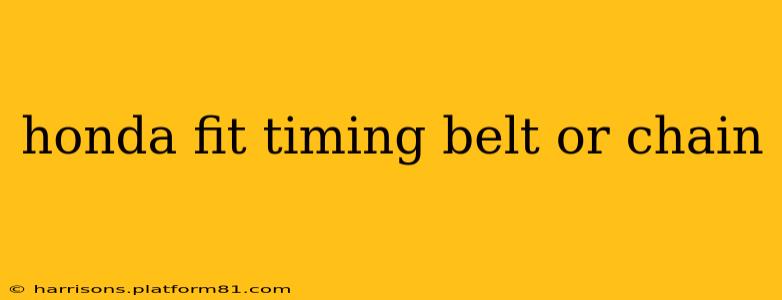The Honda Fit, a popular subcompact car known for its fuel efficiency and spacious interior, sparks a common question among owners and prospective buyers: does it have a timing belt or a timing chain? Understanding this is crucial for preventative maintenance and budgeting for long-term car ownership. The answer, however, isn't a simple yes or no. It depends on the model year.
Understanding Timing Belts and Chains
Before diving into the specifics of the Honda Fit, let's quickly differentiate between timing belts and chains. Both components synchronize the crankshaft and camshaft, ensuring proper engine operation. However, they differ significantly in material, lifespan, and maintenance requirements:
-
Timing Belt: Made of rubber and reinforced materials, timing belts have a limited lifespan and require periodic replacement (usually every 60,000-100,000 miles, depending on the vehicle). Failure of a timing belt can lead to catastrophic engine damage.
-
Timing Chain: Constructed from metal, timing chains are generally more durable and long-lasting than belts. They typically require less frequent maintenance and often outlast the engine itself. While less prone to failure, they can eventually stretch or wear out, requiring replacement, though this is far less common than belt replacement.
Honda Fit Timing System: A Year-by-Year Breakdown
The Honda Fit's timing system has evolved over the years. Here's a breakdown by generation:
-
First Generation (2007-2008): The first-generation Honda Fit utilized a timing chain. This translates to potentially less maintenance over the vehicle's lifespan.
-
Second Generation (2009-2014): The second generation also employed a timing chain. Again, this is generally considered more durable than a timing belt.
-
Third Generation (2015-2019): This generation marked a shift. The 2015-2019 Honda Fit uses a timing chain.
-
Fourth Generation (2020-Present): The latest generation of the Honda Fit continues with a timing chain.
Frequently Asked Questions (FAQs)
Here are some frequently asked questions about the Honda Fit's timing system:
How often should I replace the timing chain in my Honda Fit?
Unlike timing belts, timing chains generally don't require scheduled replacements. They are designed for the life of the engine. However, they can eventually stretch or wear out, leading to noises or performance issues. If you notice unusual noises from the engine, it's best to have your Honda Fit inspected by a qualified mechanic to check the condition of the timing chain.
What are the signs of a worn timing chain?
Signs of a worn timing chain can include a rattling or knocking noise from the engine, especially at startup. Reduced engine performance, rough idling, and a check engine light are other potential indicators.
Is it expensive to replace a timing chain?
Replacing a timing chain is a more involved process than replacing a timing belt and generally more expensive. This is due to labor costs involved in access to the chain and potential replacement of related components. It's advisable to consult a mechanic for accurate cost estimates based on your vehicle's model and condition.
What happens if the timing chain breaks in my Honda Fit?
While less likely than with a timing belt, a broken timing chain can still cause significant engine damage. This is because the valves and pistons are no longer synchronized, potentially leading to bent valves or other internal engine damage.
What is the best way to maintain my Honda Fit's timing system?
Regular maintenance, including using the correct engine oil and adhering to the recommended oil change intervals, is key to prolonging the life of the timing chain. Keeping up with scheduled maintenance will help detect potential problems early and keep your engine running smoothly.
This comprehensive guide should clarify the timing system used in your Honda Fit. Remember to always consult your owner's manual for specific maintenance recommendations and to seek professional advice from a qualified mechanic if you suspect any issues with your vehicle's timing system.
